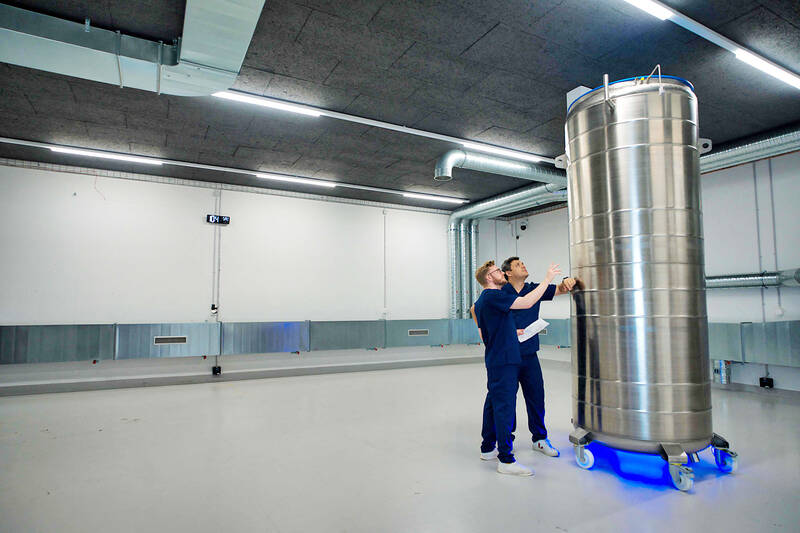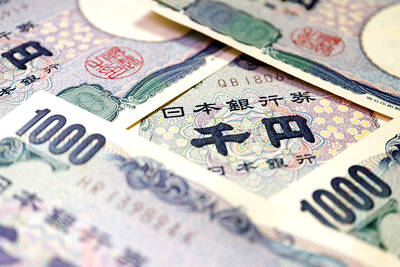Becca Ziegler is only 24, but she already has her death planned out: Her corpse would be deep-frozen to minus-200°C with liquid nitrogen. Ziegler, a US tech firm worker based in Berlin, has signed up with Tomorrow Biostasis, a start-up in the German capital that offers to cryogenically freeze a person’s body after they die.
When the time comes, a team of medics would pump her full of a chemical solution to stop ice crystals from forming in her body and then transport her mortal remains to a storage facility in Switzerland.
The hope is that one day, medical technology might be advanced enough to bring her back to life. Many experts dismiss this gamble on the future as far-fetched, but Ziegler has decided to give it a shot.

Photo: Tomorrow Biostastis, via AFP
“I’m kind of curious to see what the future would be like and, in general, I like life,” said the Californian, who works in educational technology.
“So, if I could buy myself more time, that sounds really appealing,” she said.
Once a fringe pursuit reserved for eccentric billionaires, cryogenic freezing — also known as cryonics — has become more accessible over the past years.
Several companies offering cryopreservation have sprung up in the US and elsewhere, with about 500 people worldwide thought to have been frozen so far.
A persistent myth has it that Walt Disney, the creator of Mickey Mouse, is one of them, but this has been debunked, with BBC reporting in 2019 there is “zero evidence” for this.
Tomorrow Biostasis, founded in 2020, is thought to be the first such company offering the service in Europe. It offers to freeze your body after you die and store it for a membership fee of 50 euros (US$53) a month.
A lump-sum payment of 200,000 euros — or 75,000 euros if you opt to have just your brain frozen — is also due at the time of death, a cost that can be covered by a life insurance payout.
“One of the main goals of this company is to bring the cost down ... so that cryopreservation becomes available to whoever chooses to do it,” Tomorrow Biostasis cofounder Emil Kendziorra said.
Kendziorra, 38, from the western German city of Darmstadt, studied medicine and originally worked in cancer research, but said he became frustrated with the slow pace of developments in the field.
“The one big advantage of cryopreservation is that it is something that you can do right now,” he said.
When a client dies, Tomorrow Biostasis promises to dispatch a specially equipped ambulance and a medical team that starts cooling the body using ice and water as soon as possible.
The body is then infused with a “cryoprotectant” and transported to the facility in Switzerland where it is stored in a pod surrounded by liquid nitrogen and cooled to about minus-200°C.
Tomorrow Biostasis said it has about 700 paying members, and by the end of last year had cryopreserved four people.
The typical customer is aged 30 to 40, healthy, works in technology and is more likely to be male than female, Kendziorra said.
No one has ever been brought back to life after being cryopreserved, but proponents say recent advances in technology have made the prospect more plausible.
In an experiment almost a decade ago, scientists said they were able to cryopreserve the brain of a rabbit and recover it in near-perfect condition.
This year, researchers at China’s Fudan University reported using a new technique to freeze human brain tissue so that it regained normal function after thawing.
Nonetheless, some scientists voice deep skepticism about the bet on a future return to life.
Bringing a person back to life is still a remote prospect, said Holger Reinsch, head of the Cryo Competence Center at the ILK Dresden research institute for refrigeration technologies.
“We are rather critical of the concept of cryonics... I personally would advise you against such an endeavor,” he said. “The magic limit for the life-sustaining cryopreservation of tissue structures is a frog’s heart the size of a fingernail, and this has not changed since the 1970s.”
Even Kendziorra admitted that there are no guarantees.
“I think there’s a good chance for it, but do I know for sure? Absolutely not,” he said.
However, whatever happens in the future, Ziegler is confident she would not regret her decision.
“In some ways it’s weird,” she said. “But on the other hand, the alternative is to be put in a box in the ground and get eaten by worms.”

AI TALENT: No financial details were released about the deal, in which top Groq executives, including its CEO, would join Nvidia to help advance the technology Nvidia Corp has agreed to a licensing deal with artificial intelligence (AI) start-up Groq, furthering its investments in companies connected to the AI boom and gaining the right to add a new type of technology to its products. The world’s largest publicly traded company has paid for the right to use Groq’s technology and is to integrate its chip design into future products. Some of the start-up’s executives are leaving to join Nvidia to help with that effort, the companies said. Groq would continue as an independent company with a new chief executive, it said on Wednesday in a post on its Web

RESPONSE: The Japanese Ministry of Finance might have to intervene in the currency markets should the yen keep weakening toward the 160 level against the US dollar Japan’s chief currency official yesterday sent a warning on recent foreign exchange moves, after the yen weakened against the US dollar following Friday last week’s Bank of Japan (BOJ) decision. “We’re seeing one-directional, sudden moves especially after last week’s monetary policy meeting, so I’m deeply concerned,” Japanese Vice Finance Minister for International Affairs Atsushi Mimura told reporters. “We’d like to take appropriate responses against excessive moves.” The central bank on Friday raised its benchmark interest rate to the highest in 30 years, but Bank of Japan Governor Kazuo Ueda chose to keep his options open rather than bolster the yen,

Even as the US is embarked on a bitter rivalry with China over the deployment of artificial intelligence (AI), Chinese technology is quietly making inroads into the US market. Despite considerable geopolitical tensions, Chinese open-source AI models are winning over a growing number of programmers and companies in the US. These are different from the closed generative AI models that have become household names — ChatGPT-maker OpenAI or Google’s Gemini — whose inner workings are fiercely protected. In contrast, “open” models offered by many Chinese rivals, from Alibaba (阿里巴巴) to DeepSeek (深度求索), allow programmers to customize parts of the software to suit their

Global server shipments are expected to surge to 15 million units next year, from 4 million units this year, with artificial intelligence (AI) servers accounting for about 30 percent, driven by massive capital spending by major cloud service providers, the Market Intelligence and Consulting Institute (MIC) said on Thursday last week. Major cloud service providers — including Google’s parent company Alphabet Inc, Microsoft Corp, Amazon.com Inc and Meta Platforms Inc — are projected to budget US$450 million for capital expenditure next year, up from US$400 million this year, MIC ICT [information and communications technology] Industry Research Center director Edward Lin